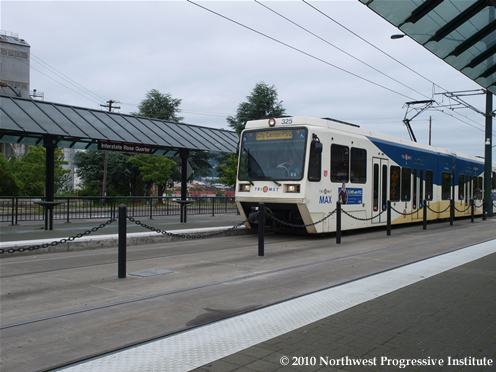Portland's MAX system offers an idea of what Link will do for us twenty years
I say continually improving because on this trip, I was happily able to do most of my commuting via light rail rather than bus. Last year, while we were opening our first light rail line in Puget Sound (Central Link) Portland's TriMet was preparing to inaugurate service on its fourth. The new MAX Green Line runs between Portland State University and Clackamas Town Center, and besides providing a convenient connection a stone's throw away from Union Station in downtown Portland, it stops only a few blocks away from where my relatives live.
This effectively meant I could wheel my baggage off Amtrak Cascades, walk down the street, hop on MAX, and be with my relatives less than a half hour after arriving at Union Station. A hassle-free trip, sans automobile. It felt great to rush past slow moving Interstate 84 traffic on the Banfield Expressway, and not have to drag my bags up a flight of steps to get on a bus. Being able to get around by train is a great blessing when you're a car-less traveler who's got a lot to carry.

To get the convention, I took the Green Line into downtown Portland, transferred to the Yellow Line at the Rose Quarter (the neighborhood that is home to the Rose Garden), got off at the second-to-last stop on the Yellow Line (Delta Park/Vanport) and got on a C-Tran bus that runs across Interstate 5 to downtown Vancouver.
I was pleased to discover that TriMet All-Day passes are honored as valid fare on C-Tran, so I didn't have to bother with counting change when I got on.
Still, it would have been nice if I didn't have to transfer to a bus at all. I hope Clark County eventually comes to it senses and accepts that it, too, needs to have a light rail system. Seattle is currently paying the price for not having approved Forward Thrust in the 1960s. We could have started building a rapid transit system then, but we didn't take the chance.
Now we're finally building a rail spine for Puget Sound. Central Link is an excellent start, but Portland's experience shows that the system will really take off and become useful when University Link, East Link, North Link, and South Link come online. Today, the corridors those new lines will run through are only served by buses, which are inefficient at moving large numbers through congested areas.
We've had express buses moonlighting as trains for way too long. When East Link opens, it will be possible for me to get from Redmond to Seattle's King Street Station (and vice versa) without ever setting foot on a bus. I won't have to build a traffic cushion into my journey, as I have to today. (Even the venerable 525 is vulnerable to congestion on southbound I-545, and it can get stuck on SR 520 approaching Lake Washington from either the east or west.)
Although I wish we had started investing in light rail when Portland did, we have benefited in some ways from designing our system more system more recently. Link is considerably quieter, for instance. MAX trains make an unpleasantly loud screeching noises, particularly when they are rounding curves. Sound Transit's trains make noise too, but not as much, and it's not as loud.
Furthermore, all of Sound Transit's trainsets, built by Kinkisharyo, are low-floor, and they align neatly at platforms, so it's easy to roll a bike, stroller, or suitcase on board any car, and no ramps are necessary to accommodate the disabled.
Conversely, the older MAX cars, built by Bombardier, have stairs behind the doors. These older cars are, however, paired with new ones so that each trainset contains a low-floor car. (I should also mention that Portland was the first city in the country to introduce light rail cars with a low-floor design.)
TriMet actually has some rolling stock that is as modern as Sound Transit's, because it bought twenty two Siemens vehicles before the opening of the Green Line. These new "Type 4" Siemens LRVs more closely resemble our thirty five Kinkisharyo LRVs, but they're not identical. TriMet has been buying MAX rolling stock exclusively from Siemens since the 1990s, whereas Sound Transit is set to continue buying from Kinkisharyo (we're supposed to get one new LRV per month starting next month).
As of 2009, Portland's MAX system serves some eighty four stations, whereas we only have thirteen stations served by one line (Central Link).
By the time Sound Transit 2 is complete, our system will be more like Portland's, with twenty three new stations served. Hopefully, by that time, voters will have passed Sound Transit 3, and additional expansion will be in the planning stages to bring light rail to even more places.
The suburban neighborhoods served by Portland's Green Line are discovering that light rail is a great way to get around. Soon, Seattle's will, too.

Comments:
Post a Comment